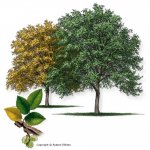This is what Texas A&M Forest Service says about it.
Tree Description:
A large tree to 75 feet tall with a tall straight trunk 2 to 3 feet in diameter and stiff branches that form a narrow, oblong crown.
Range/Site Description:
The most common elm tree in Texas, distributed widely in East, South, and Central Texas. Most often found near streams, in solid stands on flatwoods near rivers, or on dry limestone hills. Also planted widely as a landscape tree.
Leaf:
Alternate, simple, 1" to 2.5" long and 0.75" to 1" wide, oval to elliptical in shape, finely-toothed or sometimes double-toothed along the margin, and blunt at the tip. The upper surface is dark green, shiny, and rough, while the lower surface and petiole are pubescent. Twigs sometimes have thin, corky "wings" and the leaves can turn gold to orange-red in the fall.
Flower:
Appear in late summer or autumn as hairy, short-stalked clusters in the leaf axils.
Fruit:
An oval "samara," 0.25" to 0.5" long, the seed centered in the middle of the wing, deeply notched at the tip and hairy all over, especially along the margin. Seeds are borne in the fall, which distinguishes this species from the other native elms.
Bark:
Light brown to gray, with flattened ridges that break into thin, loose, flaky scales.
Wood:
Reddish-brown, brittle, with a thick layer of light-colored sapwood. The wood is sometimes used to manufacture wheel hubs, furniture, and fencing. Commonly sold in the nursery trade as a landscape tree.
Similar Species:
Winged elm (Ulmus alata) has larger leaves and seeds that mature in spring; varieties of Chinese elm (U. parvifolia) have similar leaves, but the bark is distinctly orange and flaky.




